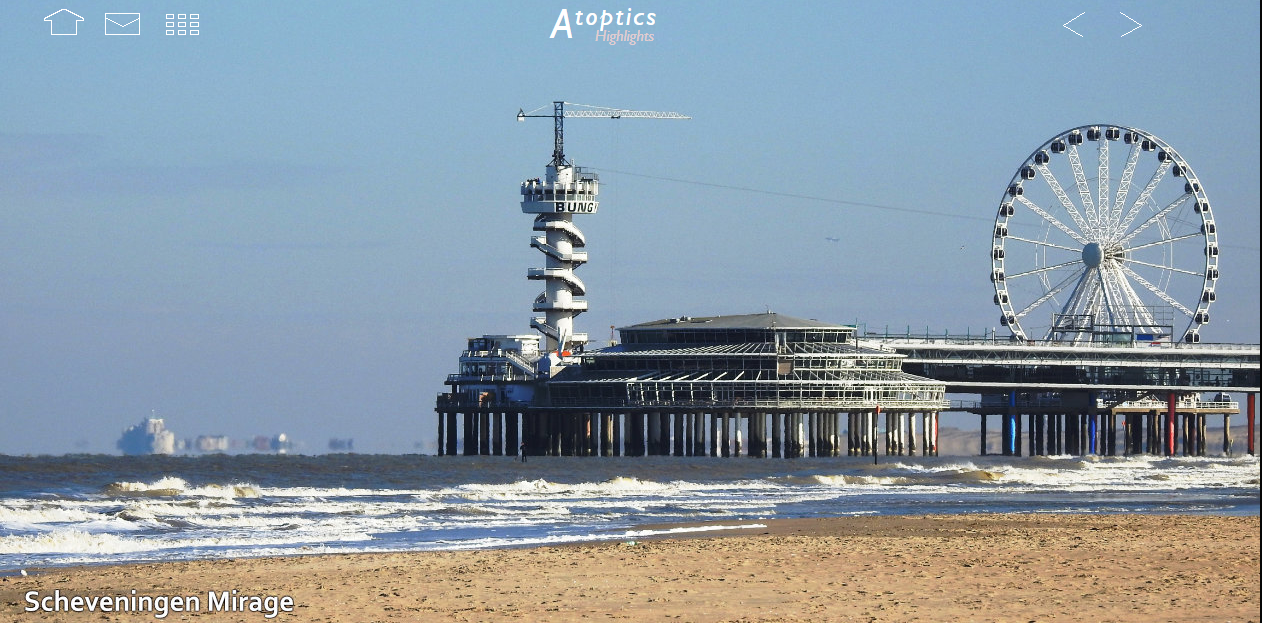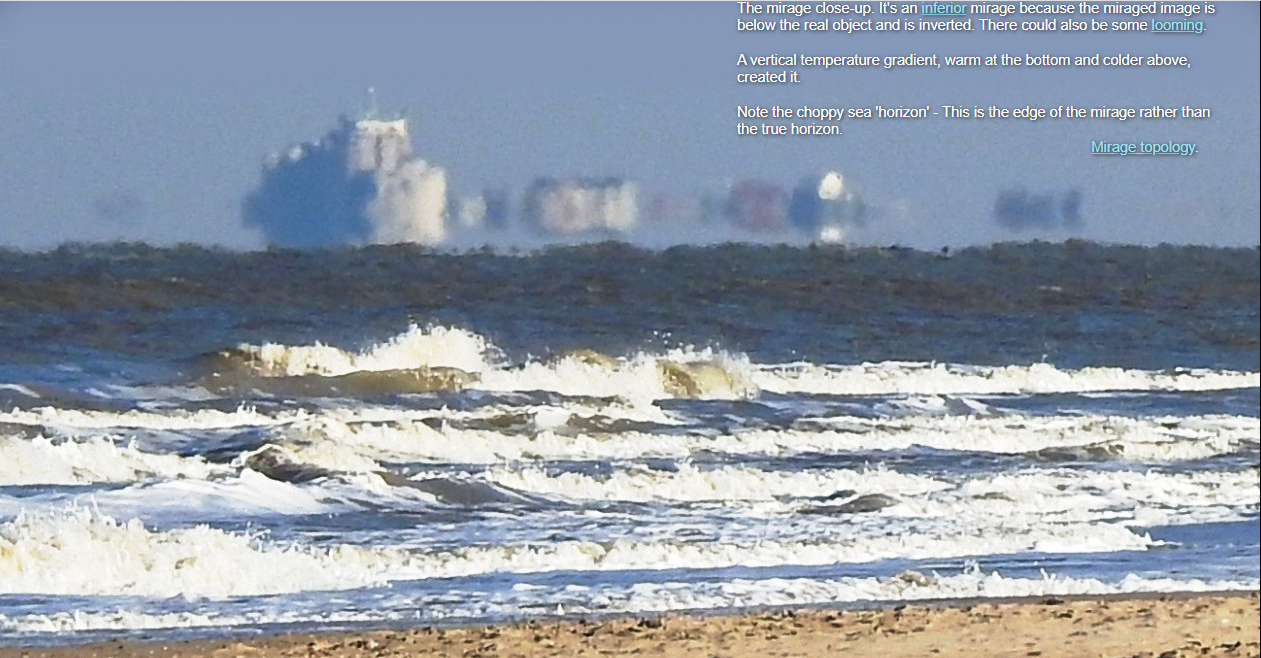Mirage at Scheveningen
Mirage at Scheveningen: A Fascinating Optical Phenomenon
Scheveningen, a picturesque coastal town near The Hague in The Netherlands, is known for its stunning views of the North Sea. However, it is also a location where one can witness a captivating atmospheric phenomenon - a mirage. In this article, we will delve into the mirage observed at Scheveningen and explore the intriguing details of this optical illusion.
The Mirage of Scheveningen
Jan Willem de Wit, a member of the Weerclub Gouda, captured an incredible image showcasing a mirage to the left of the pier at Scheveningen. The miraged buildings visible in the photograph are actually located approximately 20 kilometers away in Noordwijk, along the North Sea coast. Remarkably, the mirage extends beyond the pier columns, revealing a miraged coastline.
Unlike the telephoto shots commonly seen, this particular image provides a more accurate representation of how mirages appear to the naked eye. Typically, mirages are observed just above the horizon, usually no more than a degree in height, which is roughly equivalent to the width of a thumb when extended at arm's length. While binoculars can enhance the viewing experience, it is important to avoid looking directly at the sun.
The Anatomy of the Mirage
Upon closer inspection of the image, we can identify this as an example of an inferior mirage. In an inferior mirage, the miraged image appears below the actual object and is inverted. Additionally, there may be an element of looming present.
The formation of this mirage can be attributed to a vertical temperature gradient in the atmosphere. In this case, the lower portion of the air near the sea surface is warmer compared to the colder air above it. This temperature difference causes light rays to refract, or bend, as they pass through the different layers of air with varying densities. As a result, the miraged image of the distant buildings is formed below their actual position.
Interestingly, if we observe the sea "horizon" in the image, we can see that it appears choppy. However, this is not the true horizon but rather the edge of the mirage itself. The mirage creates a distorted representation of the sea, adding to the mesmerizing visual effect.
Exploring the Mirage Phenomenon
While we have examined the specific mirage observed at Scheveningen, it is worth exploring some general aspects of mirages to deepen our understanding of this fascinating optical phenomenon:
- Mirages are not limited to coastal areas; they can occur in various environments where there is a significant temperature gradient in the atmosphere.
- The most common type of mirage is the inferior mirage, where the miraged image appears below the actual object. However, superior mirages, where the miraged image appears above the actual object, can also occur.
- Fata Morgana is a complex form of mirage characterized by multiple inverted and stacked images. It often occurs over large bodies of water and is particularly striking when observed near the polar regions.
- Mirages can distort the appearance of objects, causing them to appear elongated, compressed, or even completely displaced from their actual location.
- The occurrence of mirages is influenced by various factors such as air temperature, humidity, and atmospheric stability.
- The phenomenon of mirages has fascinated scientists and artists alike throughout history. Artists have been known to incorporate mirages into their paintings, adding an element of mystique and optical illusion.
Conclusion
The mirage observed at Scheveningen offers a captivating glimpse into the enchanting world of atmospheric optics. This optical illusion, caused by temperature gradients in the atmosphere, creates a remarkable visual spectacle that challenges our perception of reality. Whether witnessed along coastal areas or in other diverse landscapes, mirages continue to intrigue and inspire, reminding us of the hidden wonders that can be found in the natural world.

Scheveningen is near The Hague in The Netherlands. Jan Willem de Wit (Weerclub Gouda) took this image showing a mirage to the left of the pier. The miraged buildings are at Noordwijk 20kmdistant along the North sea coast. Further miraged coastline is visible through the pier columns.
We usually see telephoto shots of mirages. This one gives a more faithful impression of their appearance to the eye. They are rarely more than a degree (a thumb's width at arms length) above the horizon. They are best searched for using binoculars - but avoid the sun.
Image ©Jan Willem de Wit, shown with permission

The mirage close-up. It's an inferior mirage because the miraged image is below the real object and is inverted. There could also be some looming.
A vertical temperature gradient, warm at the bottom and colder above, created it.
Note the choppy sea 'horizon' - This is the edge of the mirage rather than the true horizon.
Note: this article has been automatically converted from the old site and may not appear as intended. You can find the original article here.
Reference Atmospheric Optics
If you use any of the definitions, information, or data presented on Atmospheric Optics, please copy the link or reference below to properly credit us as the reference source. Thank you!
-
<a href="https://atoptics.co.uk/blog/mirage-at-scheveningen/">Mirage at Scheveningen </a>
-
"Mirage at Scheveningen ". Atmospheric Optics. Accessed on April 18, 2024. https://atoptics.co.uk/blog/mirage-at-scheveningen/.
-
"Mirage at Scheveningen ". Atmospheric Optics, https://atoptics.co.uk/blog/mirage-at-scheveningen/. Accessed 18 April, 2024
-
Mirage at Scheveningen . Atmospheric Optics. Retrieved from https://atoptics.co.uk/blog/mirage-at-scheveningen/.